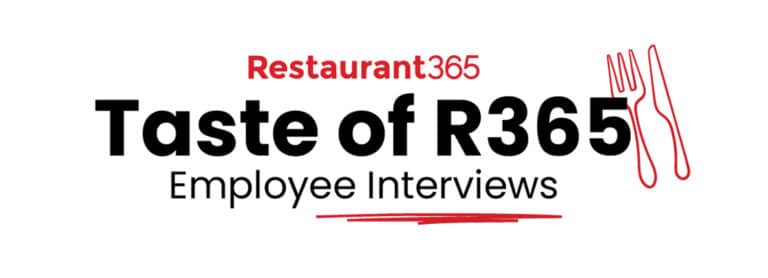
Tony Smith is Chief Executive Officer and Co-founder of Restaurant365. Since founding the company in 2011 alongside fellow Co-founders John Moody and Morgan Harris, Tony has worked to position R365 as the industry’s leading, all-in-one Restaurant Enterprise Management platform to drive restaurant efficiency, profitability, and growth. Tony primarily focuses on company vision, culture, growth, and long-term strategy.
We sat down with Tony to discuss everything from how Restaurant365 started, how it helps restaurants be their best—for guests and the bottom line—no matter what, as well as:
- The problems that could only be solved with a restaurant-specific tech solution
- How Restaurant365’s early days shaped the company today
- The foundational philosophies that drive Restaurant365
- How R365 understands and helps overcome industry challenges
- The importance of being nimble
- R365’s customer-first attitude and mission
Keep reading to get these insights and more from Tony!

A Market That Needed an All-In-One Solution
Tell us about your career prior to Restaurant365 and how that laid the groundwork for the mission to ‘Help Restaurants Thrive.’
Prior to R365, I worked with our other Co-founders, John (Moody) and Morgan (Harris), at Dynamic Methods. We were selling Microsoft solutions across a number of different industries. One solution never worked for all companies, so we were forced to customize the various features to fit each unique business. This experience opened our eyes on how connecting accounting and operations with technology could really help a business be successful. We realized that, if we found the right industry, we’d be able to go really deep and create our own fully connected solution instead of building disjointedly on top of other generic products.
How did you and your co-founders decide to focus on supporting the restaurant industry?
We started looking for an industry that was lagging in its use of technology and had a lot of room to grow. We saw what was already out there in the restaurant industry and so many restaurants were using many different solutions by cobbling them together or just doing things manually. The industry is really unique. That’s actually what drew us to it: it has so many things that are different from standard retail. Restaurants are manufacturing their product at the same time that they’re selling it. Because of that, there are a lot of complexities that come with how they’re purchasing and managing ingredients, the waste involved, the people, the labor.
All of those complexities looked to us like an opportunity to solve problems. We looked at all of the solutions available to the restaurant industry to see if any could meet those needs: fully connected accounting and operations. We couldn’t find it out there in a fully cloud–based environment. We immediately decided to start this business, came up with a name, created the company, and got to work on the product.
On the Right Track
Do you recall an early customer success story that gave you confidence that you were on the right path?
Our fourth customer was our biggest at the time, and after they’d used our system for about a year, they came back and told us they had doubled in size without adding more employees to their corporate staff. They said our system had made them that much more efficient. For me, that was huge evidence that we were on the right track to adding real value for these restaurants.
Helping You Helps Us
Can you explain this idea that R365’s success is based on our customers’ successes?
We think about everything that we do through the lens of always adding value to our customers. Because we’re a product that they’re paying for on an ongoing basis, we want to help them to be as healthy as possible so that they continue to see the value. We also want them excited to take advantage of future modules we build too. We’re a company that refuses to be stagnant. We invest heavily in R & D and we’re always creating new things. For them to see value in what we’re doing today and trust that the new things we’re coming out with are going to be just as helpful to them is the recipe for them and us to grow together.
How do we go about understanding what customers need and what will most help them achieve their big goals?
We have many ways that we connect with customers, prospects, and the industry in general to understand their needs—about our current offering as well as what else we could offer that would be of value. Our Product team talks to customers to understand what they need and then designs ideas for the Development team to work on. We also have our Support and Customer Success teams constantly working with customers to make them successful. They are, of course, also getting feedback and reading the temperature on how customers are getting value from what we’re creating.
Then, we’ve got our Sales team which is out there talking with prospects on the front line. They’re understanding—from people who aren’t yet customers—what they need and why our solution does or doesn’t meet their current needs. We also have a few people that are looking at strategic initiatives in the industry trying to say, “Where’s the industry going? What’s going to happen two years from now?” So we have a lot of different fronts where we’re reaching out to understand the highest priority needs of the industry.
Changing Times Call for Agility
What kind of lessons, best practices or philosophies for the industry have arisen during the challenges of the past couple of years and will remain?
I think the biggest thing is that people in the restaurant industry are developing a more data-driven culture and they’re adopting more technology to do it. They’re thinking about those numbers that make them most effective. That’s something that not all restaurants were doing before. Some of them were thrust into it during the pandemic, but a lot of them have been trying to move that direction for a while. When we started Restaurant365, most estimates had that the restaurant industry was spending about 2% of their revenue on technology and today it’s more like 3.5% to 4%. You can see that shift where they’re seeing the value in those tools and more helpful tools have been created for them. I think that’s one of the biggest things that we’ve seen change.
So now, 11 years after starting Restaurant365 and coming through the past few years, it’s that we want to be the system that restaurants depend on most. One that’s a full platform that they can use and a full ecosystem. One that’s very connected to the rest of the industry so that they have the smoothest experience with the technology that helps them run their business.


